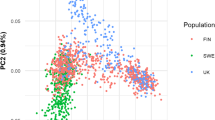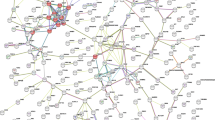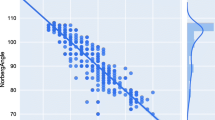Abstract
Canine hip dysplasia (CHD) is the most common hereditary skeletal disorder in dogs. To identify common alleles associated with CHD, we developed 37 informative single nucleotide polymorphisms (SNPs) within 13 quantitative trait loci (QTL) previously identified for German shepherd dogs. These SNPs were genotyped in 95 German shepherd dogs affected by CHD and 95 breed, sex, and birth year-matched controls. A total of ten SNPs significant at a nominal P value of 0.05 were validated in 843 German shepherd dogs including 277 unaffected dogs and 566 CHD-affected dogs. Cases and controls were sampled from the whole German shepherd dog population in Germany in such a way that mean coancestry coefficients were below 0.1 % within cases and controls as well as among cases and controls. We identified nine SNPs significantly associated with CHD within five QTL on dog chromosomes (CFA) 3, 9, 26, 33, and 34. Genotype effects of these nine SNPs explained between 22 and 34 % of the phenotypic variance of hip dysplasia in German shepherd dogs. The strongest associated SNPs were located on CFA33 and 34 within the candidate genes PNCP, TRIO, and SLC6A3. Thus, the present study validated positional candidate genes within five QTL for CHD.
Similar content being viewed by others
References
Bellanger JM, Astier C, Sardet C, Ohta Y, Stossel TP, Debant A (2000) The Rac1- and RhoG-specific GEF domain of Trio targets filamin to remodel cytoskeletal actin. Nat Cell Biol 2:888–892
Boichard D (2002) PEDIG: A FORTRAN package for pedigree analysis suited for large populations. Proceedings 7th world congress on genetics applied to livestock production, Montepellier, France. CD-ROM communication no. 28–13
Brass W (1993) Hüftgelenkdysplasie und Ellbogenerkrankung im Visier der Fédération Cynologique Internationale I. Kleintier-Praxis 38:194
Chase K, Lawler DF, Adler FR, Ostrander EA, Lark KG (2004) Bilaterally asymmetric effects of quantitative trait loci (QTLs): QTLs that affect laxity in the right versus left coxofemoral (hip) joints of the dog (Canis familiaris). Am J Med Genet 124:239–247
Chase K, Lawler DF, Carrier DR, Lark KG (2005) Genetic regulation of osteoarthritis: a QTL regulating cranial and caudal acetabular osteophyte formation in the hip joint of the dog (Canis familiaris). Am J Med Genet 135:334–335
Debant A, Serra-Pages C, Seipel K, O’Brien S, Tang M, Park S-H, Streuli M (1996) The multidomain protein Trio binds the LAR transmembrane tyrosine phosphatase, contains a protein kinase domain, and has separate rac-specific and rho-specific guanine nucleotide exchange factor domains. Proc Natl Acad Sci USA 93:5466–5471
Hamann H, Kirchhoff T, Distl O (2003) Bayesian analysis of heritability of canine hip dysplasia in German shepherd dogs. J Anim Breed Genet 120:258–268
Janutta V, Distl O (2006) Inheritance of canine hip dysplasia: review of estimation methods and of heritability estimates and prospects on further developments. Dtsch tierärztl Wschr 113:6–12
Janutta V, Hamann H, Distl O (2006) Complex segregation analysis of canine hip dysplasia in German shepherd dogs. J Hered 97:12–20
Janutta V, Hamann H, Distl O (2008) Genetic and phenotypic trends in canine hip dysplasia in the German population of German shepherd dogs. Berl Münch tierärztl Wschr 121:102–109
Mäki K, Janss LLG, Groen AF, Liinamo AE, Ojala M (2004) An indication of major genes affecting hip and elbow dysplasia in four Finnish dog populations. Hered 92:402–408
Marschall Y, Distl O (2007) Mapping quantitative trait loci for canine hip dysplasia in German shepherd dogs. Mamm Genome 18:861–870
Stock KF, Klein S, Tellhelm B, Distl O (2011) Genetic analyses of elbow and hip dysplasia in the German shepherd dog. J Anim Breed Genet 128:219–229
Todhunter RJ, Mateescu R, Lust G, Burton-Wurster NI, Dykes NL, Bliss SP, Williams AJ, Vernier-Singer M, Corey E, Harjes C, Quaas RL, Zhang Z, Gilbert RO, Volkman D, Casella G, Wu R, Acland GM (2005) Quantitative trait loci for hip dysplasia in a crossbreed canine pedigree. Mamm Genome 16:720–730
Wang G, Beier F (2005) Rac1/Cdc42 and RhoA GTPases antagonistically regulate chondrocyte proliferation, hypertrophy, and apoptosis. J Bone Min Res 20:1022–1031
Wang G, Woods A, Agoston H, Ulici V, Glogauer M, Beier F (2007) Genetic ablation of Rac1 in cartilage results in chondrodysplasia. Dev Biol 306:612–623
Wang G, Woods A, Sabari S, Pagnotta L, Stanton LA, Beier F (2004) RhoA/ROCK signaling suppresses hypertrophic chondrocyte differentiation. J Biol Chem 279:13205–13214
Wang G, Yan Q, Woods A, Aubrey LA, Feng Q, Beier F (2011) Inducible nitric oxide synthase-nitric oxide signaling mediates the mitogenic activity of Rac1 during endochondral bone growth. J Cell Sci 124:3405–3413
Woods A, Wang G, Dupuis H, Shao Z, Beier F (2007) Rac1 signaling stimulates N-cadherin expression, mesenchymal condensation, and chondrogenesis. J Biol Chem 282:23500–23508
Zhou Z, Sheng X, Zhang Z, Zhao K, Zhu L, Guo G, Friedenberg SG, Hunter LS, Vandenberg-Foels WS, Hornbuckle WE, Krotscheck U, Corey E, Moise NS, Dykes NL, Li J, Xu S, Du L, Wang Y, Sandler J, Acland GM, Lust G, Todhunter RJ (2010) Differential genetic regulation of canine hip dysplasia and osteoarthritis. PLoS ONE 5(10):e13219
Acknowledgments
This study and Y. Marschall were supported by the Gesellschaft zur Förderung Kynologischer Forschung e.V. (GKF), Bonn, Germany, and the Breeding Associaton of German shepherd dogs (Verein für Deutsche Schäferhunde e.V., SV), Augsburg, Germany. The authors thank the Breeding Association of German shepherd dogs (Verein für Deutsche Schäferhunde e.V., SV), Augsburg, Germany, for providing the pedigree data, X-rays, the official CHD scores and EDTA-blood samples collected for paternity testing. The authors are grateful to H. Klippert-Hasberg for expert technical assistance.
Author information
Authors and Affiliations
Corresponding author
Electronic supplementary material
Below is the link to the electronic supplementary material.
Rights and permissions
About this article
Cite this article
Fels, L., Marschall, Y., Philipp, U. et al. Multiple loci associated with canine hip dysplasia (CHD) in German shepherd dogs. Mamm Genome 25, 262–269 (2014). https://doi.org/10.1007/s00335-014-9507-1
Received:
Accepted:
Published:
Issue Date:
DOI: https://doi.org/10.1007/s00335-014-9507-1




